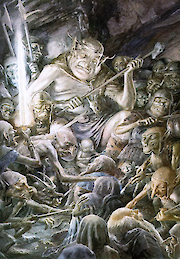☜ Click for full post text.
“Ding-dong! The Witch is dead!
Which old Witch? The Wicked Witch!
Ding-dong! The Wicked Witch is dead.
Wake up you sleepy head, rub your eyes, get out of bed.
Wake up, the Wicked Witch is dead.
She’s gone where the goblins go–
Below, below, below.
Yo-ho, let’s open up and sing and ring the bells out.
Ding-dong the merry-oh, sing it high, sing it low.
Let them know the Wicked Witch is dead!”
(E.Y. Harburg, 1939 — my additional punctuation where it seems to be needed)
Welcome, as always, dear readers. This rather blood-thirsty ditty appears, as probably all readers know, after a house lands on an unsuspecting practitioner of magic, the Wicked Witch of the East.

She may be unsuspecting, but she is also an oppressor, having previously subjugated those now singing about her demise, the Munchkins.

(This desire to dominate seems to run in her family, as her sister, the Wicked Witch of the West,

is the terror of the Winkies — who also form her bodyguard.

If this is unfamiliar to you, here’s a map to help—

When I was very little and first saw The Wizard of Oz, something in this song, although one of rejoicing, puzzled me. I knew what “goblins” were, sort of, from a poem which my grandmother used to recite, Jame Whitcomb Riley’s “Little Orphant Annie” (1885). Those goblins were mentioned at the end of most stanzas, but it was this stanza that stood out for me (it’s written in late 19th-century Midwestern US dialect, which is why some of the spelling might seem a little odd):
“An’ one time a little girl ‘ud allus laugh an’ grin
An’ make fun of ever’one, an’ all her blood an’ kin;
An’ onc’t, when they was “company,” an’ olé folks was there,
She mocked ‘em an’ shocked ‘em, an’ said she didn’t care!
An’ jist as she kicked up her heels, an’ turn’t to run an’ hide,
They was two great Black Things a‑standin’ by her side,
An’ they snatched her through the ceilin’ ‘fore she knowed what she’s about!
An’ the Gobble-uns’ll git you
Ef you
Don’t
Watch
Out!”
(If you don’t know the poem, here’s a LINK to the whole text: https://poets.org/poem/little-orphant-annie )
But, if the goblins in the song went somehow “below”, where did those two “Things” come from which took the little girl through the ceiling? My bedroom was at the top of the house, under the roof, and there were storage spaces tucked into the lower sides, each one closed by a little door,

and, when I went to bed at night, I began to be a little nervous: did we have goblins in our house? did the goblins live behind those doors?
We also had a small and very gloomy cellar, however, the dominant object being what seemed to me a gigantic coal furnace (yes, right out of the movie, Home Alone),

but away from its heat and light, there were nothing but dark, cobwebby corners.

I was as reluctant to go down there as I was to peek behind the little doors upstairs. Was this “below”?
If so, it would certainly fit in with 19th-century depictions of goblins, like those in fairy tales, both folk and literary, which my mother and grandmother read to me — and which I later read to myself– like George MacDonald’s The Princess and the Goblin (1870÷2), illustrated by Arthur Hughes,


where the goblins live in an underground kingdom, but plan to tunnel to the surface to steal the princess of the book’s title and marry her to a goblin prince. (May the idea of tunneling to the surface have been an inspiration for the gnomes of Underland in CS Lewis’ The Silver Chair (1953) and their mistress, the Lady of the Green Kirtle’s, plan to invade the upper world through a tunnel?

The goblins’ underground dwellings, however, were much larger and more elaborate than our little basement and so, as I grew, did my sense of those goblins, so that, by the time I first read The Hobbit, I could easily imagine, when Bilbo and the dwarves have been captured, that:
“…they stumbled into a big cavern.
It was lit by a great red fire in the middle, and by torches along the walls…There in the shadows on a large flat stone sat a tremendous goblin with a huge head, and armed goblins were standing around him carrying the axes and the bent swords that they use.” (The Hobbit, Chapter 4, “Over Hill and Under Hill”)

Now this was a real “below” — and, just as in the song, the place was full of goblins.
And yet there was always the lingering question, even if “below” could be answered — or at least imagined — why “below” at all? Why didn’t goblins live in villages, or trees, or on beaches? James Whitcomb Riley, after all, could suggest that some at least used a house’s upper floor (and my small person fear easily agreed with that).
But I suppose that the answer is really a very basic one. What was behind those little doors upstairs and what lay in the corners of the cellar was darkness. As Tolkien described the goblins:
“Now goblins are cruel, wicked, and bad-hearted…”
to which Treebeard adds:
“It is a mark of evil things that came in the Great Darkness that they cannot abide the Sun…” (The Two Towers, Book Three, Chapter 4, “Treebeard”)
Above or below, then, the important element was avoiding the day and perhaps it’s instructive that, when I began to worry so much about those little doors that I couldn’t sleep, my mother bought me a flashlight.

As always, thanks for reading.
Stay well,
Always carry extra batteries,
And remember that, as ever, there’s
MTCIDC
O
ps
And, if you don’t have a copy of The Princess and the Goblin, here’s a LINK to an edition from 1907, which includes Hughes’ original illustrations: https://www.gatewaytotheclassics.com/browse/display.php?author=macdonald&book=goblin&story=_front













